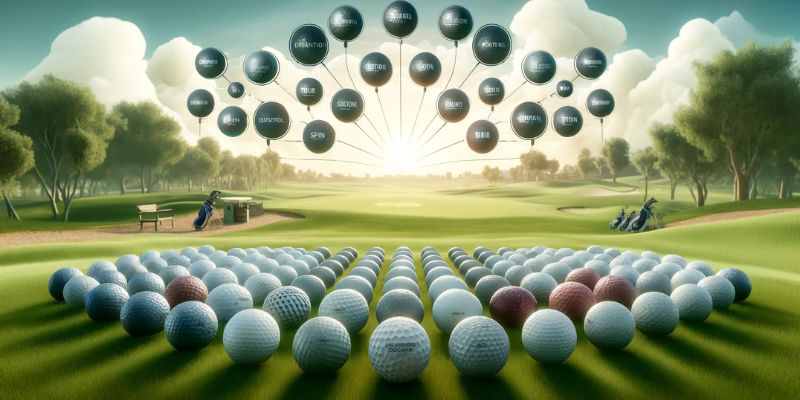When you’re ready to tee off on a misty morning or make a critical putt under the midday sun, choosing the right golf ball can profoundly impact your game.
Each golf ball is engineered differently, and understanding these differences can elevate an ordinary game to an exceptional one.
This guide aims to assist golfers at all levels, from beginners to seasoned experts, in selecting a golf ball that enhances their playing style and optimizes performance under various conditions.
Understanding Golf Ball Compression and Spin
The behavior of a golf ball upon impact is significantly influenced by its design, particularly in terms of compression and spin.
- Compression: This refers to how much the ball flattens when struck. Rated between 30 and 100, low-compression balls (30-50) are softer and better suited for players with slower swing speeds, helping them achieve greater distance. Conversely, high-compression balls (70-100) provide more control and are ideal for players with faster swings, offering a firmer touch.
- Spin: Golf balls are also categorized by their spin levels—low, mid, and high. Low-spin balls minimize air resistance and reduce wind effects, making drives longer and straighter. Mid-spin balls strike a balance, offering a good blend of distance and tactile feedback, suitable for most players. High-spin balls increase backspin on impact, which is crucial for control near the greens and favored by advanced players aiming to finesse their shots.
Understanding these characteristics is essential for choosing a golf ball that complements your style of play, particularly if you aim to enhance specific aspects of your performance.
Best Golf Balls for Distance
For those prioritizing reach, especially players with slower swings, certain golf balls are engineered for maximum distance, generally featuring lower compression and reduced spin. Here are some top picks, with average pricing:
- Titleist Velocity ($27 per dozen): Known for its high-speed LSX core technology, this ball is designed to maximize ball speed and distance.
- Callaway Warbird ($20 per dozen): Features a large, soft high-energy core that significantly boosts speed and distance, making it ideal for those looking to improve their long game.
- Nike PD Long ($18 per dozen): A cost-effective option that offers reduced spin off the tee, enhancing distance for recreational players.
These golf balls are tailored to help you achieve greater accuracy and distance, improving your long game dramatically.
Golf Balls for Control and Feel
While achieving distance is crucial, many seasoned players prefer golf balls that offer better control and a softer feel, particularly around the greens.
Such golf balls usually have three-piece designs and softer covers, which enable more spin and precision:
- Titleist Pro V1 ($50 per dozen): Continues to be the benchmark for superior performance, providing an excellent mix of distance, steady flight, and soft feel, along with superb greenside control.
- Bridgestone Tour B XS ($45 per dozen): Preferred by professional players like Tiger Woods, this ball increases spin and control thanks to its soft urethane cover, perfect for enhancing your short game.
- Callaway Chrome Soft ($47 per dozen): This ball features a Graphene-infused Dual SoftFast Core that achieves a high launch and low spin off the tee for longer distances, paired with a soft feel and better control for approach shots.
Choosing a golf ball that excels in control and feel can significantly improve your accuracy and confidence, especially in vital short game scenarios.
Selecting the right golf ball is as crucial as choosing the best golf clubs.
Whether purchasing for personal use or as a thoughtful gift for a fellow golfer, consider the player’s swing speed, desired ball flight, and preferred feel.
By grasping the nuances of compression, spin, and golf ball construction, you can pick a golf ball that not only suits your needs but also enhances your overall game, turning close misses into triumphant moments on the greens.
What factors should I consider when choosing a golf ball?
Consider compression, spin, and your personal playing style. Compression affects how the ball deflects upon impact, with lower compression suitable for slower swings, and higher compression for faster swings. Spin affects the ball’s flight path and behavior on the green, with options ranging from low-spin for longer drives to high-spin for greater control.
How does compression affect golf ball performance?
Compression measures the deflection a ball undergoes when hit. Low-compression balls (30-50 rating) are softer and better for players with slower swing speeds, maximizing distance. High-compression balls (70-100 rating) provide more control and are suited for players with faster swing speeds.
What are the best golf balls for distance?
For maximum distance, look for balls with lower compression and spin. Examples include the Titleist Velocity, known for its high-speed core; Callaway Warbird, with a soft high-energy core; and the Nike PD Long, which is designed to deliver less spin and more distance.

